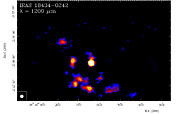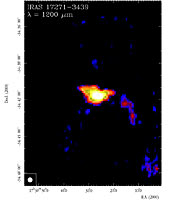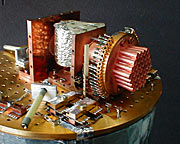Pressemitteilung
Hunting the Southern Skies with SIMBA
First Images from the New "Millimetre Camera" on SEST at La Silla
30. August 2001
A new instrument, SIMBA ("SEST IMaging Bolometer Array"), has been installed at the Swedish-ESO Submillimetre Telescope (SEST) at the ESO La Silla Observatory in July 2001. It records astronomical images at a wavelength of 1.2 mm and is able to quickly map large sky areas. In order to achieve the best possible sensitivity, SIMBA is cooled to only 0.3 deg above the absolute zero on the temperature scale.
SIMBA is the first imaging millimetre instrument in the southern hemisphere. Radiation at this wavelength is mostly emitted from cold dust and ionized gas in a variety of objects in the Universe. Among other, SIMBA now opens exciting prospects for in-depth studies of the "hidden" sites of star formation, deep inside dense interstellar nebulae. While such clouds are impenetrable to optical light, they are transparent to millimetre radiation and SIMBA can therefore observe the associated phenomena, in particular the dust around nascent stars .
This sophisticated instrument can also search for disks of cold dust around nearby stars in which planets are being formed or which may be left-overs of this basic process. Equally important, SIMBA may observe extremely distant galaxies in the early universe, recording them while they were still in the formation stage.
Various SIMBA images have been obtained during the first tests of the new instrument. The first observations confirm the great promise for unique astronomical studies of the southern sky in the millimetre wavelength region.
These results also pave the way towards the Atacama Large Millimeter Array (ALMA), the giant, joint research project that is now under study in Europe, the USA and Japan.
First observations with SIMBA
SIMBA ("SEST IMaging Bolometer Array") was built and installed at the Swedish-ESO Submillimetre Telescope (SEST) at La Silla (Chile) within an international collaboration between the University of Bochum and the Max Planck Institute for Radio Astronomy in Germany, the Swedish National Facility for Radio Astronomy and ESO.
The SIMBA ("Lion" in Swahili) instrument detects radiation at a wavelength of 1.2 mm. It has 37 "horns" and acts like a camera with 37 picture elements (pixels). By changing the pointing direction of the telescope, relatively large sky fields can be imaged.
As the first and only imaging millimetre instrument in the southern hemisphere, SIMBA now looks up towards rich and virgin hunting grounds in the sky. Observations at millimetre wavelengths are particularly useful for studies of star formation, deep inside dense interstellar clouds that are impenetrable to optical light. Other objects for which SIMBA is especially suited include planet-forming disks of cold dust around nearby stars and extremely distant galaxies in the early universe, still in the stage of formation.
During the first observations, SIMBA was used to study the gas and dust content of star-forming regions in our own Milky Way Galaxy, as well as in the Magellanic Clouds and more distant galaxies. It was also used to record emission from planetary nebulae, clouds of matter ejected by dying stars. Moreover, attempts were made to detect distant galaxies and quasars radiating at mm-wavelengths and located in two well-studied sky fields, the "Hubble Deep Field South" and the "Chandra Deep Field" [1].
Observations with SEST and SIMBA also serve to identify objects that can be observed at higher resolution and at shorter wavelengths with future southern submm telescopes and interferometers such as APEX (see MPG ESO Press Release eso0114 of 6 July 2001) and ALMA.
SIMBA images regions of high-mass star formation
Some of the recent SIMBA images are shown above; they were taken during test observations, and within a pilot survey of high-mass starforming regions.
Stars form in interstellar clouds that consist of gas and dust. The denser parts of these clouds can collapse into cold and dense cores which may form stars. Often many stars are formed in clusters, at about the same time.
The newborn stars heat up the surrounding regions of the cloud . Radiation is emitted, first at mm-wavelengths and later at infrared wavelengths as the cloud core gets hotter. If very massive stars are formed, their UV-radiation ionizes the immediate surrounding gas and this ionized gas also emits at mm-wavelengths. These ionized regions are called ultra compact HII regions .
Because the stars form deep inside the interstellar clouds, the obscuration at visible wavelengths is very high and it is not possible to see these regions optically. The objects selected for the SIMBA survey are from a catalog of objects, first detected at long infrared wavelengths with the IRAS satellite (launched in 1983), hence the designations indicated in the accompanying images.
From 1995 to 1998, the ESA Infrared Space Observatory (ISO) gathered an enormous amount of valuable data, obtaining images and spectra in the broad infrared wavelength region from 2.5 to 240 µm (0.025 to 0.240 mm), i.e. just shortward of the millimetre region in which SIMBA operates. ISO produced mid-infrared images of field size and angular resolution (sharpness) comparable to those of SIMBA.
It will obviously be most interesting to combine the images that will be made with SIMBA with imaging and spectral data from ISO and also with those obtained by large ground-based telescopes in the near- and mid-infrared spectral regions.
Some technical details about the SIMBA instrument
SIMBA is unique because of its ability to quickly map large sky areas due to the fast scanning mode. In order to achieve low noise and good sensitivity, the instrument is cooled to only 0.3 deg above the absolute zero, i.e., to -272.85 °C.
SIMBA consists of 37 horns (each providing one pixel on the sky) arranged in a hexagonal pattern, c.f. ESO Press Photo eso0131. To form images, the sky position of the telescope is changed according to a raster pattern - in this way all of a celestial object and the surrounding sky field may be "scanned" fast, at speeds of typically 80 arcsec per second. This makes SIMBA a very efficient facility: for instance, a fully sampled image of good sensitivity with a field size of 15 arcmin x 6 arcmin can be taken in 15 minutes. If higher sensitivity is needed (to observe fainter sources), more images may be obtained of the same field and then added together.
Large sky areas can be covered by combining many images taken at different positions. The image resolution (the "telescope beamsize") is 22 arcsec, corresponding to the angular resolution of this 15-metre telescope at the indicated wavelength.
Endnoten
[1] Observations of the HDFS and CDFS fields in other wavebands with other telescopes at the ESO observatories have been reported earlier, e.g. within the ESO Imaging Survey Project (EIS) (the "EIS Deep-Survey"). It is the ESO policy on these fields to make data public world-wide.
Kontaktinformationen
Lars-Ake Nyman
The SEST Team
La Silla, ESO
E-Mail: lnyman@eso.org
Über die Pressemitteilung
| Pressemitteilung Nr.: | eso0131 |
| Legacy ID: | PR 20/01 |
| Name: | Instrumentation, IRAS 17175-3544, IRAS 17271-3439, IRAS 18434-0242, NGC 6334 |
| Typ: | Milky Way : Nebula : Appearance : Emission : H II Region |
| Facility: | Swedish–ESO Submillimetre Telescope |
| Instruments: | SIMBA |
Our use of Cookies
We use cookies that are essential for accessing our websites and using our services. We also use cookies to analyse, measure and improve our websites’ performance, to enable content sharing via social media and to display media content hosted on third-party platforms.
ESO Cookies Policy
The European Organisation for Astronomical Research in the Southern Hemisphere (ESO) is the pre-eminent intergovernmental science and technology organisation in astronomy. It carries out an ambitious programme focused on the design, construction and operation of powerful ground-based observing facilities for astronomy.
This Cookies Policy is intended to provide clarity by outlining the cookies used on the ESO public websites, their functions, the options you have for controlling them, and the ways you can contact us for additional details.
What are cookies?
Cookies are small pieces of data stored on your device by websites you visit. They serve various purposes, such as remembering login credentials and preferences and enhance your browsing experience.
Categories of cookies we use
Essential cookies (always active): These cookies are strictly necessary for the proper functioning of our website. Without these cookies, the website cannot operate correctly, and certain services, such as logging in or accessing secure areas, may not be available; because they are essential for the website’s operation, they cannot be disabled.
Functional Cookies: These cookies enhance your browsing experience by enabling additional features and personalization, such as remembering your preferences and settings. While not strictly necessary for the website to function, they improve usability and convenience; these cookies are only placed if you provide your consent.
Analytics cookies: These cookies collect information about how visitors interact with our website, such as which pages are visited most often and how users navigate the site. This data helps us improve website performance, optimize content, and enhance the user experience; these cookies are only placed if you provide your consent. We use the following analytics cookies.
Matomo Cookies:
This website uses Matomo (formerly Piwik), an open source software which enables the statistical analysis of website visits. Matomo uses cookies (text files) which are saved on your computer and which allow us to analyze how you use our website. The website user information generated by the cookies will only be saved on the servers of our IT Department. We use this information to analyze www.eso.org visits and to prepare reports on website activities. These data will not be disclosed to third parties.
On behalf of ESO, Matomo will use this information for the purpose of evaluating your use of the website, compiling reports on website activity and providing other services relating to website activity and internet usage.
Matomo cookies settings:
Additional Third-party cookies on ESO websites: some of our pages display content from external providers, e.g. YouTube.
Such third-party services are outside of ESO control and may, at any time, change their terms of service, use of cookies, etc.
YouTube: Some videos on the ESO website are embedded from ESO’s official YouTube channel. We have enabled YouTube’s privacy-enhanced mode, meaning that no cookies are set unless the user actively clicks on the video to play it. Additionally, in this mode, YouTube does not store any personally identifiable cookie data for embedded video playbacks. For more details, please refer to YouTube’s embedding videos information page.
Cookies can also be classified based on the following elements.
Regarding the domain, there are:
- First-party cookies, set by the website you are currently visiting. They are stored by the same domain that you are browsing and are used to enhance your experience on that site;
- Third-party cookies, set by a domain other than the one you are currently visiting.
As for their duration, cookies can be:
- Browser-session cookies, which are deleted when the user closes the browser;
- Stored cookies, which stay on the user's device for a predetermined period of time.
How to manage cookies
Cookie settings: You can modify your cookie choices for the ESO webpages at any time by clicking on the link Cookie settings at the bottom of any page.
In your browser: If you wish to delete cookies or instruct your browser to delete or block cookies by default, please visit the help pages of your browser:
Please be aware that if you delete or decline cookies, certain functionalities of our website may be not be available and your browsing experience may be affected.
You can set most browsers to prevent any cookies being placed on your device, but you may then have to manually adjust some preferences every time you visit a site/page. And some services and functionalities may not work properly at all (e.g. profile logging-in, shop check out).
Updates to the ESO Cookies Policy
The ESO Cookies Policy may be subject to future updates, which will be made available on this page.
Additional information
For any queries related to cookies, please contact: pdprATesoDOTorg.
As ESO public webpages are managed by our Department of Communication, your questions will be dealt with the support of the said Department.




